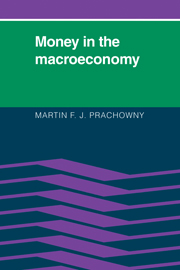Book contents
- Frontmatter
- Contents
- List of charts, figures, and tables
- Preface
- List of symbols
- 1 The roles of money and monetary policy in the macroeconomy
- 2 A model of the macroeconomy
- 3 The new classical model: the case against stabilization policy
- 4 The institutionalist model: the case for stabilization policy
- 5 The demand for money
- 6 The supply of money
- 7 The monetary mechanism
- 8 U.S. monetary policy and the dilemma of stagflation
- 9 A model of an open economy
- 10 Managed exchange rates and monetary policy
- 11 Monetary policy in Canada and its macroeconomic consequences
- 12 Improving the monetary policy apparatus
- Index
11 - Monetary policy in Canada and its macroeconomic consequences
Published online by Cambridge University Press: 26 October 2011
- Frontmatter
- Contents
- List of charts, figures, and tables
- Preface
- List of symbols
- 1 The roles of money and monetary policy in the macroeconomy
- 2 A model of the macroeconomy
- 3 The new classical model: the case against stabilization policy
- 4 The institutionalist model: the case for stabilization policy
- 5 The demand for money
- 6 The supply of money
- 7 The monetary mechanism
- 8 U.S. monetary policy and the dilemma of stagflation
- 9 A model of an open economy
- 10 Managed exchange rates and monetary policy
- 11 Monetary policy in Canada and its macroeconomic consequences
- 12 Improving the monetary policy apparatus
- Index
Summary
INTRODUCTION
In this chapter the various threads that were developed in the preceding two chapters will be pulled together to show how monetary policy influenced the performance of the Canadian economy from 1975 to 1982. The purpose is to show how the IS-LM-AS model, especially the open-economy version, can be used to analyze real macroeconomic problems and policies. It runs parallel to Chapter 8, which dealt with the U.S. experience, but it does not necessarily emphasize the same issues; whereas Chapter 8 focused on supply shocks, this chapter will highlight the role played by monetary targets in the Canadian economy. However, although monetary events and policies receive pride of place in this account, other factors were also at work and their effects must be incorporated into the discussion of the period.
HIGHLIGHTS OF THE PERIOD
Supported by the data in Table 11-1, the following general observations can be made about macroeconomic developments in Canada between 1975 and 1982:
Throughout the period, Canada suffered from high and variable inflation. The growth rate of the GNE price deflator reached 15.3% in 1974; its low point for the whole period was 6.8%. The size of inflation makes accurate predictions desirable, but the variability of inflation makes these predictions very difficult.
Interest rates tended to move up and down with the inflation rate. Their high variability made it unattractive for both borrowers and lenders to enter into long-term contracts.
[…]
- Type
- Chapter
- Information
- Money in the Macroeconomy , pp. 289 - 314Publisher: Cambridge University PressPrint publication year: 1986



